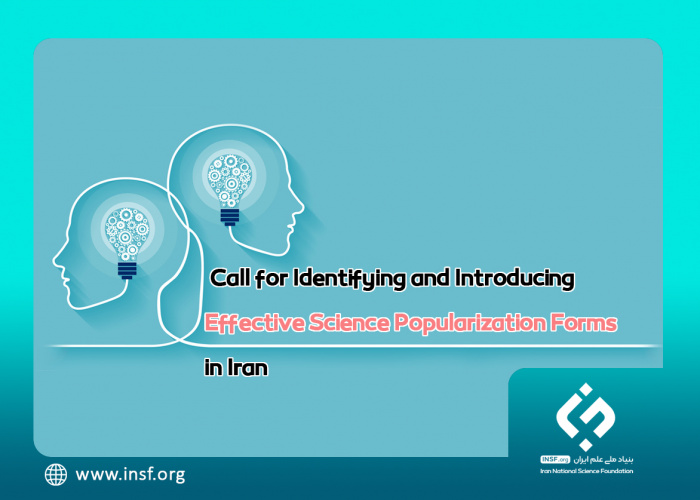Call for Identifying and Introducing Effective Science Popularization Forms in Iran

In line with its goals of supporting research and promoting science, the Iran National Science Foundation (INSF) announces a call with the theme of "identifying and introducing the characteristics of effective forms of science popularization in Iran."
Call Details:
Terms such as science popularization, 4th generation universities, universities and research institutes without walls, and universities or research institutes with open doors have entered the collective discourse of Iranian society. These terms fall under the concept of "The Third Mission," which means "helping society." Scientific institutions have been under pressure to expand their focus beyond education and conducting research, and to add the third mission to their work—a mission that is multidisciplinary, complex, and evolving in nature and is broadly interconnected to the social and economic mission of scientific institutions.
Several universities around the world have already established departments dedicated to connecting the research activities of their faculty members, students, and staff with the wider society. The wider society refers to different audience groups, including ordinary people, experts in other fields of study, policymakers, legislators, the market, and industries.
The mandate of such departments is to help researchers simplify the content of their technical field, make it more attractive, and adapt it to a specific audience. In other words, the target audience of research is determined, and the content is accordingly modified or popularized based on their level of understanding and field of work. In addition to simplification, the purpose of the content, such as the transfer of information or change of attitude, is also determined, and the technical content suitable for the purpose and the language of the audience is provided. Recognizing the needs of different target groups also occurs during this process.
This process generally has two main stages: (a) simplification without misinformation, mainly done by the researchers themselves or with their supervision by a person who has expertise in this field, and (b) framework establishment, which is done by artists, graphic designers, writers, etc. The output of this process is a general scientific text in visual, audio, written, or multimedia formats. Researchers and scientists are the people in charge of the whole process. Therefore, to fulfill the Third Mission in Iranian universities, it is necessary to prepare a guideline or a manual that will teach them the principles and methods of correct simplification of technical scientific texts and also make them familiar with various formats and frameworks. After deciding on the nature of the general science they want, the text should be simplified and given to the implementation team to proceed with the supervision of the researcher.
In other words, the work of researchers does not end with the completion of their research, but like an innovator of soft technologies, they must think about the types of outputs that can be extracted from their work, which may include "popular science," and at the same time, manage and monitor the process. The final goal of this call is to prepare a guidebook that will help researchers and scientists in managing and monitoring this process. Popular science is an explanation, interpretation, or version of science that is prepared for a general audience. It may be prepared by science journalists or scientists and presented in various formats such as books, films, and television documentaries, magazine articles, and web pages. Some effective forms of science popularization include:
- Science journalism: which focuses on recent and new scientific findings and makes them available to the general public.
- Science books: cover a wide range of topics and are often written by scientists or science journalists.
- Scientific documentaries: are broadcast on TV or streaming services and present scientific information visually.
- Scientific journals: which include articles related to new scientific findings on various scientific topics.
- Scientific websites: these are websites that make scientific information accessible to audiences.
- Social networks: are used to engage people in science for enhancing science popularization activities.
- Comic strips: which are used to visually convey complex scientific information to the public.
Expected Outputs:
- Article
- Guidebook
- Policy report
Eligibility:
- Faculty members of all universities and research institutes
- Doctoral students (in case they meet the INSF regulations for doctoral thesis grants, proposals can only be submitted by the student’s first supervisor)
Funding Format:
- Research Project Grant: A specific research project carried out by a full-time faculty member in an Iranian university or research institute.
- Doctoral Thesis Grant: A specific research project carried out by a full-time doctoral student within the scope of their doctoral thesis, and under the supervision of their thesis supervisor.
Responsible Review Group:
Applications shall be reviewed by the Science Popularization Review Group of INSF through the INSF Research Management System.
Deadline:
The deadline for the call is February 14, 2024.

